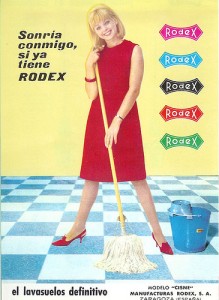Inventos “Made in Spain” Posted by Magda on Nov 4, 2010 in Spanish Culture
De España han salido grandes inventos de las mentes de algunos personajes brillantes. Aunque son numerosos, me voy a centrar en los más sorprendentes, y también bastante útiles.
Imaginemos a una mamá con su hijo bien vestido. De repente, al chiquillo le apetece un caramelo. La madre se pone nerviosa, pues conoce el resultado: el caramelo pegajoso terminará en las manos, en la cara, y por supuesto, en la ropa del pequeño. Esta imagen era típica, hasta que alguien tuvo una brillante idea: ¡hincar un palo en el caramelo para poder sujetarlo sin mancharse, y de paso evitar el riesgo de atragantarse! Esta persona fue Enric Bernat, y gracias a él tenemos el famoso Chupa Chups. El diseño del logo es obra de Dalí nada menos, y ayudó a su fulminante éxito mundial. En 1995 el Chupa Chups llegó al espacio de manos de astronautas rusos. Mi favorito, el que llevaba el nombre de la serie protagonizada por Telly Savalas en los años 60, Kojak.
Siguiente imagen: una pobre mujer, de rodillas sobre el suelo, dejándolo reluciente (por supuesto, los hombres no fregaban). Hasta que un buen día, alguien pensó en atar un palo a una bayeta de tiras, y estrujarla en un cubo con unos rodillos accionados por un pedal: así se evitaba esta incómoda postura. Contrariamente a lo que pueda parecer, no fue una mujer, sino un oficial del ejército del aire, Manuel Jalón Coromillas, quien en el año 1956 tuvo esta idea. En principio él le dio el nombre de fregasuelos, pero pasó a ser conocida con el nombre de la persona que realizaba esa tarea, “la fregona”. Hoy día es uno de los productos más exportados, en gran número de países se conoce, ¡e incluso la usan los hombres!
Por último, volvemos a otro invento que nació para hacer felices también a los pequeños, aunque hoy día lo disfruten casi más los mayores: más concretamente a niños mutilados durante la guerra civil española. Alejandro Campos “Finisterre”, poeta, editor e inventor gallego, pasó algún tiempo herido en un hospital, y observó la tristeza de los chavales que por sus heridas no podían jugar al fútbol. Así que cuando se recuperó, encargó un prototipo curioso: un tablero de madera, con figuras de futbolistas incrustados en unas varillas metálicas, simulando un campo de fútbol. No es difícil imaginar la sonrisa que debió arrancar a los chiquillos. Hoy día es muy usado en reuniones de amigos. ¿Qué mejor forma de pasar un buen rato que jugar al futbolín, sobre todo si ganas, y los perdedores pagan tu ronda?
Some great inventions have come out of the minds of brilliant Spanish characters. Although we have a lot to choose from, I will focus today on the most surprising, and also quite useful.
Let’s imagine a mother with her well-dressed child. Suddenly, the kid demands some candy. The mother grows anxious, since she knows the expected result: the sticky candy will end up all over the child’s hands, face, and clothes, of course. This used to be a typical image, until someone had a brilliant idea: put a stick into the candy so it can be held, and thus avoid stains and the risk of choking! This person was Enric Bernat, and thanks to him we have the famous Chupa Chups. The logo was designed by none other than Dali, and contributed to its immediate worldwide success. In 1995 Chupa Chups made it to space in the hands of Russian cosmonauts. My favorite chupa chup is the one named after the series Kojak, played by Telly Savalas in the 60s.
Next scenario: a miserable woman, kneeling on the floor and scrubbing it (evidently, men didn’t scrub floors). Until one day someone thought of joining a handle and a stripped cloth, and straining it into a bucket using some rolls activated by a pedal: that way this uncomfortable position would be avoided. Contrary to what you may think, it wasn’t a woman, but an air force officer, Manuel Jalon Coromillas, who devised this idea in 1956. First he named it “fregasuelos” (floor scrubber), but it became known by the name of the person who carried out this task, “la fregona”. Today it is one of our most exported products, known in many countries, and even men are able to use it!
Finally, let’s go back to another invention that was also conceived to make children happy, even though it is mostly enjoyed by adults today. More specifically, it was made for children who had been crippled during the Spanish civil war. Alejandro Campos “Finisterre”, a Galician poet, editor, and inventor, spent some time recovering from his wounds in a hospital, and took notice of the children’s sadness about not being able to play football because of their injuries. When he recovered, he commissioned an interesting prototype: a wooden table, with little football player figures skewered along metal rods, simulating a football playing field. Today it is very common in friend gatherings. What better way to spend a good time than playing some fussball? Especially when you win and the losers have to buy the next round!

Build vocabulary, practice pronunciation, and more with Transparent Language Online. Available anytime, anywhere, on any device.






Comments:
vatsal dixit:
sir,
For a language learner like me,if the translation is given side by side then it will be very convenient and useful.In fact, in a website of about.com same method is adopted and I appreciate that very much since it helps me improve my vocabulary very conveniently.
Shellie Manoi:
Outstanding post, I believe website owners should learn a lot from this site its very user genial .